By James Heinz
In a recent article about the Roger Street Fishing Museum, I noted that the original Great Lakes fishermen used a type of small sailboat called a Mackinac boat, a replica of which is on display at that museum.
The Mackinac (pronounced Mackinaw) boat’s design begins with the Native American canoe. The canoe was double ended, flat bottomed, shallow drafted, and could carry a surprisingly large cargo for its size. However, it was not stable with a mast and sail because it lacked a centerboard to counteract the mast, and required many people to paddle it.
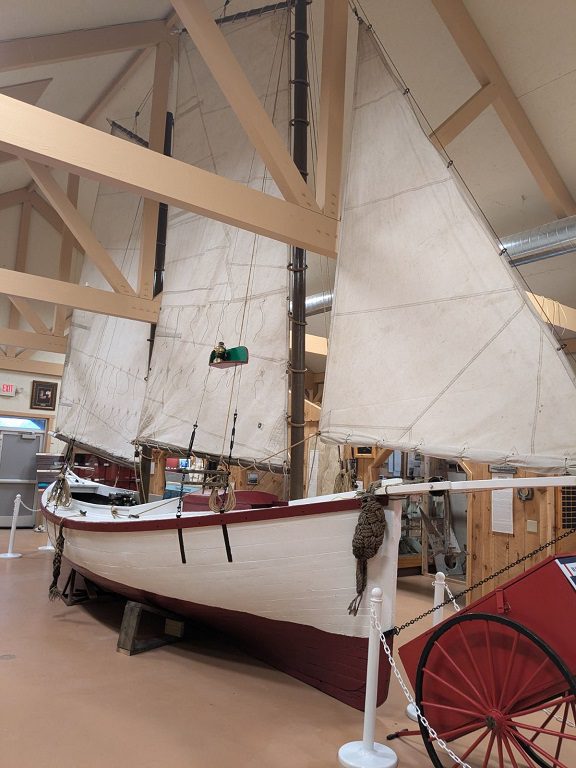
Roger Street Fishing Museum
It is difficult to trace the Mackinac boat’s exact origin because they seem to have evolved from attempts to fit centerboards, masts and sails to native canoes. These experiments were conducted in the vicinity of the Straits of Mackinac, for which the boats were named.
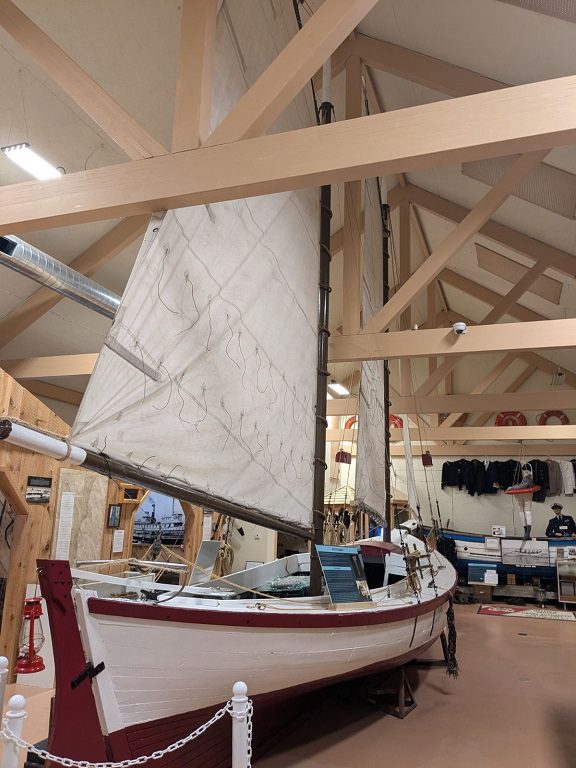
Roger Street Fishing Museum
In addition, the boat originated in the early days of the frontier and documentation is lacking. They were first built for the fur trade. The American Fur Company, which was the Wal-Mart of the frontier, had a trading post at the Straits of Mackinac.
The boats proved to be extremely successful, so much so that from 1815 through the 1830s the boats were the most popular type used on the western Lakes. One source described Mackinac boats as “the pickup trucks of the frontier.”
American Fur and others, including the U.S. Army, used them extensively not only on the Lakes but on the western rivers, including the Wisconsin River and on the Missouri River all the way to the head of navigation in Montana. Once Native Americans realized how useful the Mackinac boats were, they built them too.
Tracing the evolution of the boats is difficult because they were built in small, undocumented boatyards, not shipyards, and there was no standardized size or design. The size and shape of each boat varied depending upon the builder’s tradition, and the buyer’s preferences. The still existing Burger Boat Company started by building Mackinac boats at Manitowoc, Wis., in 1863.
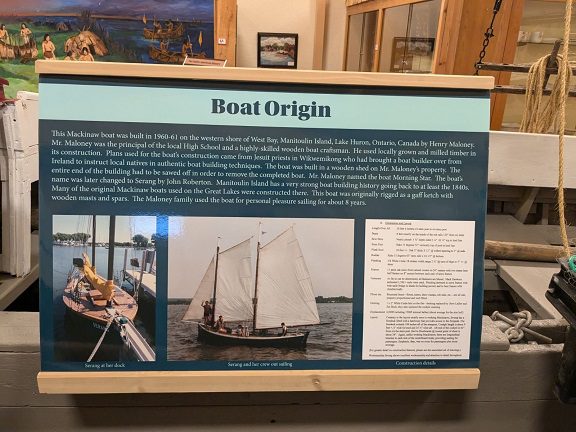
Roger Street Fishing Museum
Also, each Great Lake had their own distinctive design. There was a Lake Erie boat, and a Lake Huron boat as well as several different variants of the Mackinac boat. This article concerns the variant built on Lake Michigan and Lake Superior.
The WMHS files contain the authoritative AMERICAN SMALL SAILING CRAFT by noted naval historian Howard Chapelle. He describes the Mackinac boats as “These were unquestionably the finest of the Lake boats…a very strong sheer, and a high, bold bow, almost plumb stem; marked rake to the post; and much drag to the keel. The beam is carried well forward and the run is long and fine.”
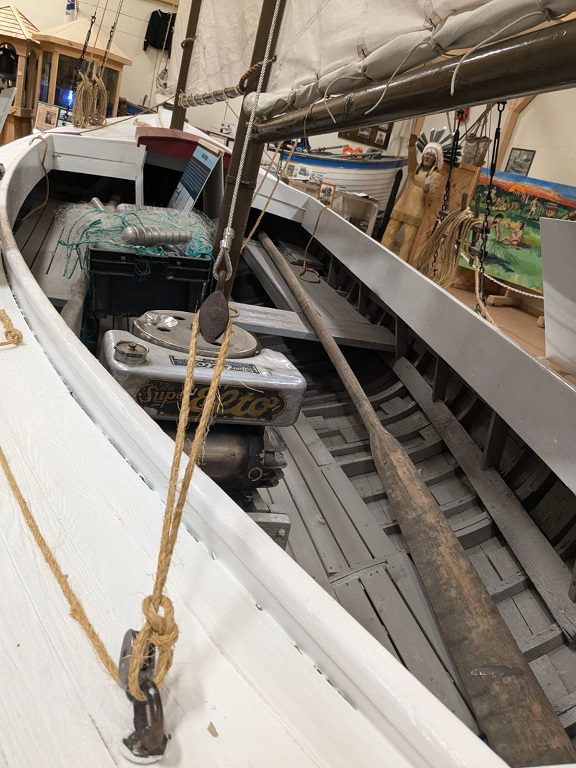
Roger Street Fishing Museum
The boat’s advantages were that they were fast and seaworthy, could be pulled up on a beach, could be rowed or sailed, and were inexpensive enough for the common man to afford. They could haul more cargo with fewer men than a native canoe, which required many paddlers. Mackinac boats could be sailed by one or two men.
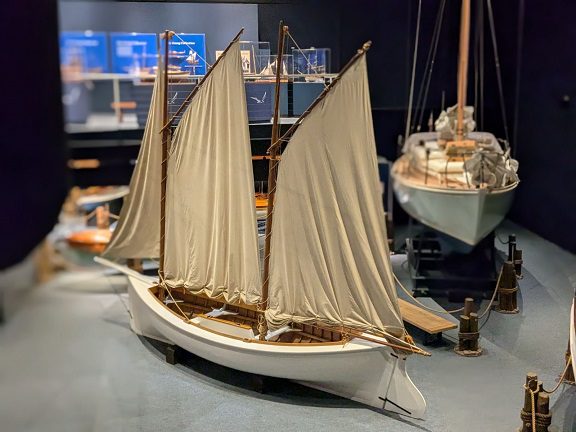
Wisconsin Maritime Museum
The boats were all double ended and they ranged in size from 26 feet long to almost 40 feet. They were all about 8 feet wide and drew about two feet of water. Their centerboard was retractable. Some of the boats were partially decked forward and had a small cabin, or “cuddy” in the bow.
The frame of the boats were generally made of oak, and in many cases the planking was also of oak. They were made of frames either sawn to size or bent to shape in a steam box
They all had two masts. The masts were sometimes but not always of equal height and the boats were schooner or ketch rigged. Their bowsprits (the horizontal pole in the bow of the boat) pointed down.
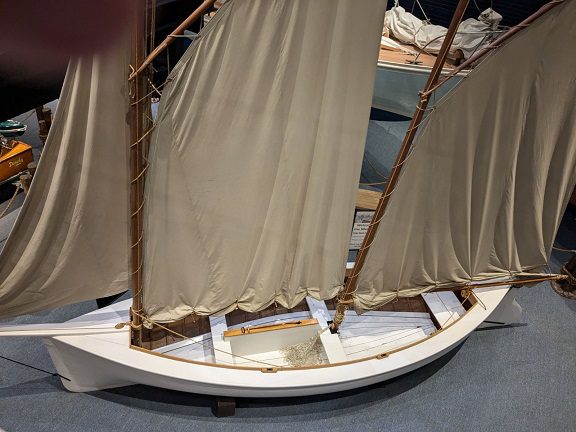
Wisconsin Maritime Museum
When the fur trade declined, the commercial fishing industry quickly adopted them. The boat’s seaworthiness was welcome on the Lakes where storms can suddenly appear without warning. Their speed enabled their catch to be brought to shore quickly enough for the fish to be cleaned and salted before the fish spoiled, and their cargo capacity made a fishing trip worthwhile. As fishing boats, they could be used for long line, pound net, or gill net fishing. The boats were inexpensive enough that they could be purchased for about $150 in the 1880s.
The boats were also used for personal transportation and light cargo hauling from one port to another.
As noted in the article on the Rogers Street fishing museum, invention of the small gasoline engine put an end to the need for boats that had to be rowed or sailed, and permitted the construction of much larger fishing boats. Some Mackinac boats lingered on as private yachts, but the design died out, except for reconstructions like the one in the Rogers Street museum.
The Mackinac boat in the Rogers Street museum is called the SERANG. It was built in 1960-1961 on Manitoulin Island, Ontario, by a high school principal who owned it for eight years. It is 26.5 feet long and 8 feet wide on the inside. The frames are made of oak and the planking and decking of white cedar. It was originally rigged as a gaff ketch.
An exhibit at Rogers Street states that the boats used a 2-3 man crew to fish 3-4 miles from shore in 15-30 feet of water. Each boat carried 4 or 5 boxes of nets which when deployed were tied together extending about a mile in total. The exhibit states that the boats’ disadvantages were that the crew was exposed to weather and would have to row the boat back to shore in the absence of wind.
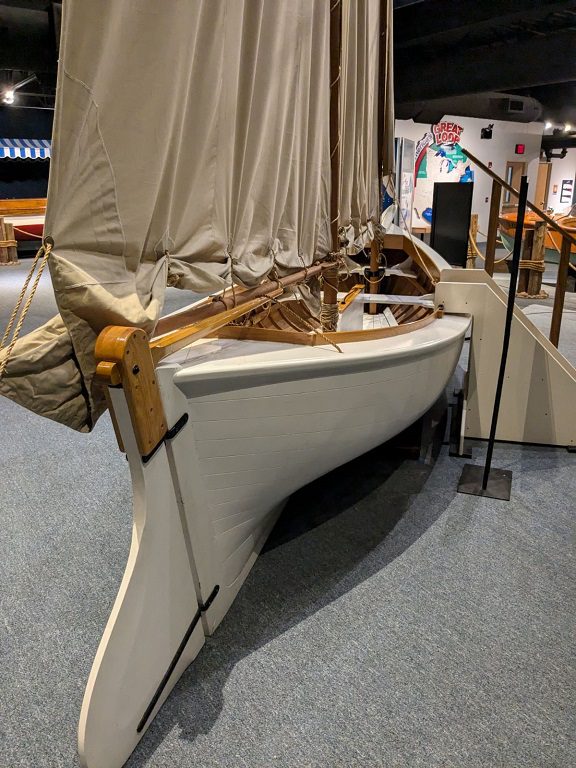
Wisconsin Maritime Museum
Down the road from the Rogers Street Museum in Two Rivers, Wis., another reconstructed Mackinac boat rests in the Wisconsin Maritime Museum in Manitowoc, Wis.
____________________________________
James Heinz is the Wisconsin Marine Historical Society’s acquisitions director. He became interested in maritime history as a kid watching Jacques Cousteau’s adventures on TV. He was a Great Lakes wreck diver until three episodes of the bends forced him to retire from diving. He was a University of Wisconsin – Milwaukee police officer for thirty years. He regularly flies either a Cessna 152 or 172.
Photos by James Heinz

